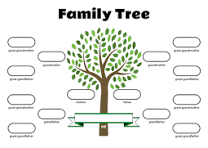Unveiling Your Roots: Creating a Comprehensive Complete Family Tree
The Importance of Creating a Complete Family Tree
Building a complete family tree is not just about listing names and dates; it is about preserving your family’s history and understanding your roots. A complete family tree provides a comprehensive view of your ancestry, connecting you to the past and helping you make sense of your present.
One of the key benefits of creating a complete family tree is the sense of belonging and identity it can offer. By tracing your lineage back through generations, you can uncover stories, traditions, and values that have been passed down through your family. This knowledge can help you appreciate where you come from and understand the experiences that have shaped your family over time.
Furthermore, a complete family tree can serve as a valuable resource for future generations. By documenting your ancestors’ names, relationships, and vital information, you are creating a lasting legacy that can be passed down to your children, grandchildren, and beyond. This not only preserves your family’s history but also provides future generations with a sense of continuity and connection to their roots.
Creating a complete family tree also has practical benefits. It can help you identify genetic health risks that may run in your family, enabling you to make informed decisions about your health and well-being. Additionally, knowing your familial connections can facilitate networking with distant relatives who may share common interests or valuable information about your shared heritage.
In conclusion, building a complete family tree is more than just an exercise in genealogy; it is an opportunity to explore your past, connect with your present, and preserve your legacy for the future. Whether you are just starting out or have been researching for years, embarking on the journey to create a comprehensive family tree can be a rewarding experience that enriches both your personal understanding and appreciation of your familial heritage.
Essential FAQs for Creating and Completing Your Family Tree
- 1. How do I start building my family tree?
- 2. What information should I include in a complete family tree?
- 3. How can I verify the accuracy of my family tree research?
- 4. Are there any online resources or tools that can help me create a family tree?
- 5. What are the benefits of DNA testing for genealogy and tracing a family tree?
- 6. How can I fill in gaps or missing information in my family tree?
- 7. What is the best way to organize and display a complete family tree?
1. How do I start building my family tree?
To start building your family tree, begin by gathering information from your immediate family members. Interview relatives to collect names, dates of birth, marriage details, and any other pertinent information about your ancestors. Utilize family documents such as birth certificates, marriage licenses, and old photographs to verify the information you gather. Organize your findings using a genealogy software or online platform to create a solid foundation for your family tree. As you progress, consider reaching out to distant relatives, exploring online databases, and visiting local archives or libraries to expand your research and uncover more branches of your family tree. Remember that patience, thoroughness, and attention to detail are key when embarking on the journey of building a complete family tree.
2. What information should I include in a complete family tree?
When creating a complete family tree, it is essential to include a range of information to ensure its comprehensiveness and accuracy. Start by documenting the full names, birth dates, and death dates of each individual in your family, including their relationships to one another. Include details such as marriage dates, locations, and any significant life events or achievements. Don’t forget to add important historical context, such as immigration records, military service, or notable occupations. Including photographs, documents, and stories can also enrich your family tree and provide a more personal touch. By compiling a diverse array of information, you can create a detailed and vivid representation of your family’s history for generations to come.
3. How can I verify the accuracy of my family tree research?
Verifying the accuracy of your family tree research is a crucial step in ensuring the reliability and validity of your findings. To validate the information in your family tree, it is essential to cross-reference multiple sources, such as birth certificates, marriage records, census data, and other official documents. Additionally, reaching out to living relatives for firsthand accounts and corroborating details can help confirm the accuracy of your research. Conducting thorough fact-checking and critically evaluating each piece of information will not only strengthen the integrity of your family tree but also provide a more comprehensive and reliable representation of your ancestry.
4. Are there any online resources or tools that can help me create a family tree?
When it comes to creating a family tree, there are numerous online resources and tools available to assist you in your genealogical journey. Websites such as Ancestry.com, MyHeritage, and FamilySearch offer user-friendly platforms that allow you to input information about your relatives, search historical records, and connect with other researchers. These online resources provide access to vast databases of birth records, marriage certificates, census data, and more, making it easier than ever to piece together your family history. Additionally, there are specialized software programs like Legacy Family Tree and RootsMagic that offer robust features for organizing and visualizing your family tree. Whether you are a beginner or an experienced genealogist, leveraging these online resources can streamline the process of creating a comprehensive and accurate family tree.
5. What are the benefits of DNA testing for genealogy and tracing a family tree?
DNA testing for genealogy offers a multitude of benefits when tracing a family tree. One key advantage is the ability to confirm or discover biological relationships, helping to validate traditional genealogical research and uncover unexpected connections. DNA testing can also provide insight into ethnic origins, allowing individuals to explore their ancestral roots with greater precision. Additionally, DNA results can help break through brick walls in genealogical research by connecting individuals with genetic matches who share common ancestors, facilitating collaboration and the exchange of valuable information. Overall, DNA testing enhances the depth and accuracy of family tree research, offering a powerful tool for unraveling the mysteries of one’s heritage.
6. How can I fill in gaps or missing information in my family tree?
When faced with gaps or missing information in your family tree, there are several strategies you can employ to continue building a comprehensive picture of your ancestry. Start by revisiting existing records and documents to see if any details may have been overlooked or misinterpreted. Utilize online genealogy databases, archives, and resources to search for additional information or connect with other researchers who may have relevant data. Interview living relatives to gather oral history and anecdotes that could shed light on missing branches of the family tree. Collaborating with fellow genealogists, joining forums, and attending workshops can also provide valuable insights and guidance on how to fill in the gaps in your family tree effectively.
7. What is the best way to organize and display a complete family tree?
When it comes to organizing and displaying a complete family tree, there are several effective methods to consider. One popular approach is to use genealogy software or online platforms that allow you to input and visualize your family tree in a structured format. These tools often provide features such as customizable charts, detailed profiles for each individual, and the ability to add photos and documents. Another option is to create a physical family tree chart or poster, which can be a visually appealing way to showcase your lineage and make connections between generations. Additionally, organizing your research into folders or binders can help keep documents and records organized for easy reference. Ultimately, the best way to organize and display a complete family tree depends on personal preference and the level of detail you wish to include in documenting your ancestry.

